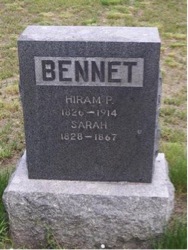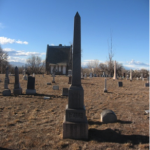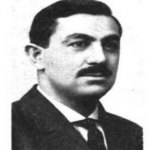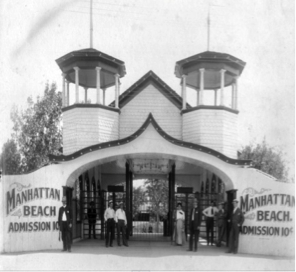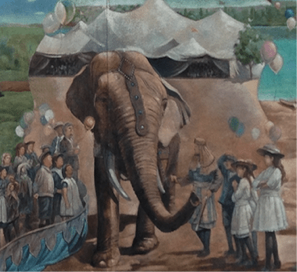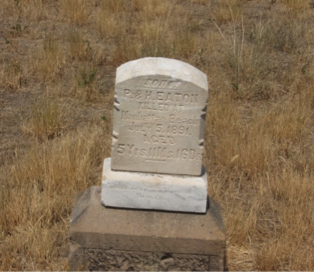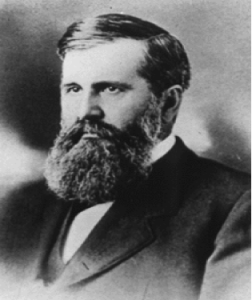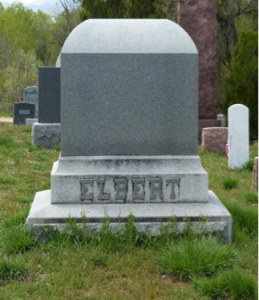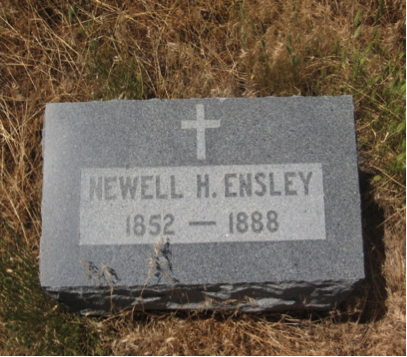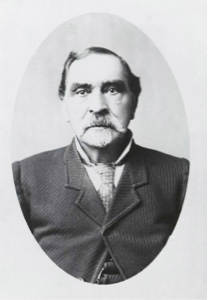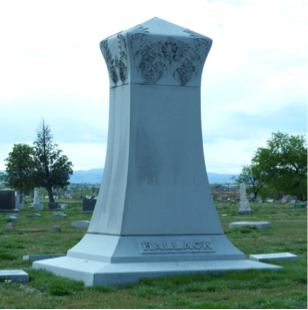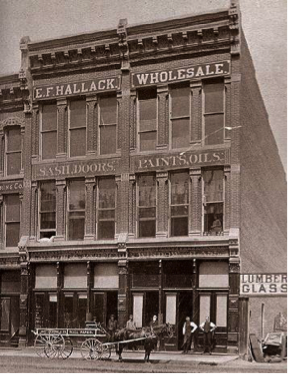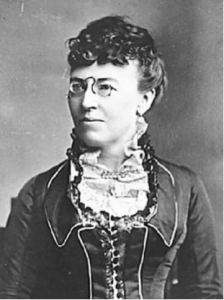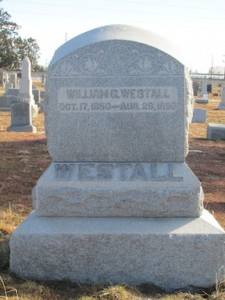Riverside Biographies
Bennet, Hiram P. (1826-1914)
Cass, Oscar David (1823 – 1894)
Eaton, George W. (1885 -1891)
Elbert, Samuel Hitt (1833-1899)
Ensley, Elizabeth Piper (1848-1919)
Ford, Barney Launcelot (1822-1902)
Hallack, Erastus F. (1829-1897)
Tabor, Augusta (1833-1895)
Westall, William G. “Billy” (1853-1893)
============================================================
Hiram P. Bennet
Hiram P Bennet was born in Carthage, Maine, on September 02, 1826. He moved to Richland County, Ohio in 1831 at the age of five, then to Andrew County, Missouri in 1839 where he continued his education. He later taught school in Missouri while studying law, and was admitted to the bar in 1851. At that time he moved to Glenwood, Iowa and was appointed as a judge of the circuit court of Iowa in 1852. In 1854 he moved to Nebraska City, Nebraska Territory and was elected as a member of the first territorial legislative assembly in 1855.
When gold was discovered in Colorado he thought it might be a good opportunity for a young lawyer. He arrived as a pioneer in 1859 and partnered with Moses Hallett under the firm name of Bennet & Hallett. He soon found, due to the demands of building new homes and businesses, that lumber was more in demand than a lawyer. He kept his law office but also partnered with Nathan Wyatt in a sawmill about 30 miles south of Denver on Running Creek. He was elected as a delegate to the United States Congress in 1861 and again in 1862.
He is buried next to his wife Sarah, in Block12, Lot 67.
Information courtesy of:Biographical Directory of the United States Congress, Real Pioneers of Colorado, Maria Davies McGrath, Denver Museum 1934, Nebraska State Historical Society, and Findagrave.com
Oscar David Cass
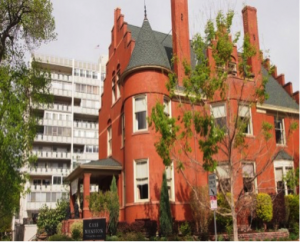
Oscar David Cass was born in Lyman, New Hampshire on August 2, 1823. He was the son of the Rev. Moses G. Cass and Sophia Thurstin (both also buried in the Cass family plot).
Dr. Cass received his medical license on June 18, 1845 from the Vermont Medical College. After graduation he practiced medicine in several states around the country, including in California during the 1849 Gold Rush. During this time, he was often paid in gold dust; because of this he learned how to grade and weigh gold.
A member of the pioneer families, Dr. Cass arrived in Denver on May 13, 1860. He opened a medical practice with Dr. John Hamilton, serving as the physician while Dr. Hamilton was the surgeon. There were many doctors in the growing city of Denver, but not many ore exchange houses to serve miners and merchants. From his time in California Dr. Cass knew the value of gold, and saw an opportunity in this new line of business. When his brother Joseph B. Cass arrived from Leavenworth, Kansas, they opened a broker’s office in the Hinckley Express Company. Business was brisk, allowing the men to eventually construct their own building at G and McGaa, now 16th and Market.
Their business continued to grow with the onset of the Civil War, which caused the price of gold to skyrocket. With their continuing success and profits, the brothers entered the real estate business. In 1860, Dr. Cass purchased property at 16th and Curtis in downtown Denver, then partnered with Dr. J. W. Graham to build the Cass & Graham block on the property.
Dr. Cass married Emogene M. Babcock they had two daughters and a son. Their son Oscar David Cass Jr., who died on June 27, 1928, is buried at Fairmount Cemetery in Block 87.
In 1891, the family bought five lots at 733 E. 8th Ave. to build their dream home. The Cass Mansion at 8th Ave. and Washington St. was built for $13,000, a staggering sum at the time. Construction started in 1893, but wasn’t finished until 1898, four years after Dr. Cass died. The family lived in the house until 1918.
Dr. Oscar David Cass died on December 14, 1894. He is buried in the family plot, Block 05, Lot 89.
Biography by DL Hennesy, Edited by K. Alexander.
Photo credits: Headstone-FHRC collection, Cass Mansion-2017 Doors Open, Portrait-1895 History of Colorado, Volume III
References: 2017 Doors Open, 1895 History of Colorado, Volume III
George W. Eaton
This is the tragic story of the short life of George W. Eaton. George was born in Denver on July 19, 1885 and died on July 5, 1891 at only 5 years of age. His father, Pressley, worked for the railroad while his mother, Harriet, was a homemaker, caring for George and his younger brother Oscar in their home at 3722 Franklin Street.
One summer day the family decided to spend their Sunday having a picnic at Denver’s recently opened Manhattan Beach amusement park.
Located on the shore of Sloane’s lake, Manhattan Beach opened on June 27, 1881 and was the first amusement park west of the Mississippi. It had several attractions, including a roller coaster, Ferris wheel, boats rides around the lake, wrestling bears, hot air balloon rides, and a large theater for plays and vaudeville acts.
The main attraction at the park was a twenty-year-old elephant named Roger (his real name was Rajah). He was large even for an elephant, but a gentle giant that loved to give children rides on his back in a basket. Roger had been giving rides to children at the City Zoo before coming to Manhattan Beach.
Due to the size of the crowd that the park that day, Roger was moved from his usual spot to one closer to the hot air balloon ride. George was waiting in line with other children to ride on Roger when finally he and five other children had their turn in the basket. During their ride the burners on the balloon were fired to life, spooking the elephant. Roger’s keeper, Fred King, was able to get the elephant under control so the children could get off. Unfortunately, before George was able to get out of the basket, the melee again spooked Roger and George fell to the ground. The elephant’s massive hoof came down on his head, killing him instantly.
Though no fault of his own, this event sealed Roger’s fate. After the crowds had left the park Fred King led Roger into present day Edgewater and put him down. Though no one knows for certain, it has always been the rumor that the elephant was buried at 20th and Depew, under what was previously a King Soopers. Perhaps at some point in the future construction or development will confirm the location of Roger’s last resting place.
Following the accident, the Eaton family left Denver, moving to Coeur d’Alene, Idaho to take up farming with Pressley’s brother. In a strange twist of fate, while Pressley was bringing a load of firewood back to the house his wagon slid off the road and slipped down an embankment. He was thrown from the wagon and his head was pinned between the wagon and a rock. Pressley Eaton was killed in 1904 at the age of fifty, in same way as his son George had died thirteen years earlier.
George is the only member of the Eaton family buried at Riverside. He is buried in Block 25, Lot 170.
Biography by DL Hennesy-Edited by K. Alexander
Photo credits: Headstone-FHRC collection, other – Denver Public Library, Western History Collection
Samuel Hitt Elbert
Samuel Hitt Elbert was born in Logan County, Ohio, on April 3, 1833. He was the son of physician and surgeon Dr. John Downs Elbert and Achsa Hitt Elbert. Samuel studied law and graduated from Ohio Wesleyan University in 1854. He continued his law studies over two more years in Dayton, OH before being admitted into the bar. Elbert then moved to Plattsmouth, Nebraska where he started his law practice. In 1860 he was elected to the Nebraska legislature, beginning his career of public service.
In 1862 president Lincoln appointed Mr. Evans to the post of Secretary of Colorado Territory, which was served under Governor John Evans. One of the duties of the Secretary of Colorado was to fill in as acting governor when Governor Evans was unavailable. It was during one of these absences that Evans signed the Hundred Day Authorization mobilizing the Second and Third Colorado Volunteer Regiments. This mobilization was to protect Colorado against the Confederacy and hostile Indians. Colonel John M. Chivington was put in charge. This action put into motion the events that lead to the Sand Creek massacre and the eventual removal from office of Governor Evans in 1865. Elbert continued his service as Secretary of the Territory under Governor Alexander Cummings until 1867.
Samuel Elbert married Josephine Evans, the daughter of the governor he’d served under, in June of 1865.
On April 4, 1873 President Ulysses S. Grant appointed Elbert to be Colorado’s sixth Territorial Governor. Elbert realized that water and irrigation would be needed if Colorado were to grow into statehood. To address this need, he became one of the founders of the Western Irrigation Conference. This conference wrote many of the state’s water laws, some of which are still in place today.
In 1880, Judge Elbert was promoted to Chief Justice of the Colorado Supreme Court, where he served until resigning due to poor health in 1889.
Samuel Elbert has a county, city and mountain peak named for him. On February 13, 1874 the 10th Territorial Legislature removed two of Colorado’s seventeen counties and added six, one of which was Elbert County. Mt. Elbert, Colorado’s highest mountain, was named for him in part to recognize his efforts to open the Southern Ute land to mining and railroads.
Governor Samuel Elbert died on November 27, 1899 and is buried in Block 13, Lot 68.
Bio by D. L. Hennesy, edited by K. Alexander
References: www. wikipedia.org, www.Colorado State Archives
Pictures 1) portrait, Colorado State Archives. (2-3) headstones, Friends of Historic Riverside Cemetery collection.
Elizabeth Piper Ensley
Elizabeth Piper was born in the Caribbean on June 15, 1848 where she spent her childhood and received her formal education. At the age of eighteen she went abroad to Germany and France where she received her college degree.
Miss Piper moved to Boston on December 22, 1870 where she taught school and was responsible for establishing a public library. On July 22, 1882 she married Newell H. Ensley. Together they moved to Washington, D. C. where they both taught at Howard University.
Around 1887 the Ensleys came west and settled in Denver. At the time Denver’s black community was only about two percent of the total population. Colorado was still reeling from the Silver Panic of 1893 and Denver was crowded with unemployed miners and their families. Elizabeth started reform efforts; calling on contacts she had in Boston and Washington to help fund relief for the poor.
As an African American woman Mrs. Ensley was also very involved in civil rights, equality for all and the women’s right to vote. Colorado was one of first states to grant women the right to vote, however under the Colorado State Constitution of 1876 it was only in local school board elections. In 1893 Elizabeth helped to form the Colorado Equal Suffrage Association with the goal of allowing women to vote in all elections. She served as the organization’s treasurer. On November 07, 1893 women won the right to vote in all elections in Colorado. Following this change Elizabeth organized the Woman’s League to help black women understand the issues, the importance of voting and how to vote.
In 1904 Mrs. Ensley founded the Colorado Association of Colored Women’s Club to support community issues and education programs. She was also a reporter for the “Woman’s Era”, the first monthly newspaper published by and for African-American woman.
Elizabeth died on June 6, 1919 at the age of 70. At the time of her death she lived in a craftsman house at 855 S. Emerson. She is buried in her family’s plot: Block 02, Lot 156
Biography by DL Hennesy-Edited by K. Alexander
Photo credits: Headstone-FHRC collection, portrait – Denver Public Library, Western History Collection.
Barney Launcelot Ford

Barney Launcelot Ford was born into slavery on January 22, 1822 on a plantation in Stafford County, Virginia. His father was the white plantation owner and his mother was a black slave named Phoebe. When their “Master” died they were sold to an owner in South Carolina, where Barney grew up. Being determined that Barney would learn to read and write, his mother took him to an educated slave to learn these skills.
His last owner rented him to a riverboat that hauled cotton on the Mississippi. He learned to cook while on this riverboat. When the boat docked at Quincy, Illinois in 1848, at age twenty-six, Barney just walked away. With the help of the underground railway he made it to Chicago where he met Harry O. Wagoner, a fellow African-American. Although Harry was from Maryland, he was never a slave. They formed a lifelong friendship. Wagoner owned a livery stable and he hired Barney to work there, allowing him to sleep in the hayloft. At the stable Berney met Julia Lyoni, Wagoner’s sister-in-law, and they were married in 1849. As slaves were not given last names, Julia helped him pick one. The idea for his name came from a steam engine called the Launcelot Ford. After their marriage Julia loaned him the two dollars needed to learn the barber trade.
In 1851, they decided to move to California to follow the gold rush. Rather than travel across country, they chose to travelled by ship around Cape Horn. During the voyage the ship stopped at Greytown, Nicaragua, and finding it to their liking, they stayed, opening a hotel and restaurant called The United States Hotel. After the hotel was destroyed by fire in 1854 they returned to Chicago where Mr. Ford bought his old friend Wagoner’s livery stable.
In 1860 the lure of gold brought the Fords to Breckenridge, Colorado. At the time African-Americans could not own property in Colorado. An unscrupulous lawyer advised Ford to put the claim into the lawyer’s name with a verbal agreement that Ford could keep any profits. When it looked like Barney was about to strike it rich, the lawyer evicted him from his property.
After this loss, the Ford’s came to Denver and Barney opened a barbershop on Larimer Street. He lost the shop in the great fire, which destroyed most of downtown Denver in April 1863. Knowing of Ford’s good business skills, local investor Luther Kountze loaned him nine thousand dollars to rebuild. Ford did rebuild and was able to repay the loan with interest in ten months. The rebuilt building was a brick two-story building at 1514 Blake Street that still stands today. It was called The People’s Restaurant and had a barbershop on the first floor and a restaurant on the second.
In 1860, Barney convinced his friend Harry O. Wagoner to come to Denver and be his partner after Mr. Wagoner lost his mill in Chicago to a fire. Once in Denver, Wagoner built the Inter-Ocean Hotel at 1436 16th Street (16th & Blake). The hotel was four stories with bronze chandeliers and red velvet curtains. It opened on October 29, 1873 and was a great success.
In 1871, the Fords established the first adult education classes for African-Americans in Colorado. Barney spent the rest of his life fighting in Colorado and Washington D.C. for equal rights for blacks in Colorado.
Julia died of pneumonia in 1899 and Barney died of a stroke at his home at 16th and Race in 1902. They are buried in Block 20 next to their long time friend Harry O. Wagoner and his wife.
Biography by D. L. Hennesy. Compiled with the assistance of www.everything2.com, www.blackpast.org, www.coloradovirtuallibrary.org, www.wikipedia.orgPhotos courtesy the Western History Department, Denver Public Library and the Friends of Historic Riverside Cemetery.
Erastus F. Hallack
Erastus Hallack was born in New York on May 30, 1829. In 1863 he moved to Highland, Kansas, where he started a successful carriage manufacturing business. He sold the business in 1866 and within a year had started across the plains towards Denver with several ox-drawn wagons of corn to sell. As his brother Charles Hallack had also recently arrived in Denver, Erastus decided to stay and join him in the lumber business.
Together they entered into a partnership with Dr. John H. Morrison (Block 01, Lot 02 – one of the original founders of Riverside Cemetery) forming the Hallack Brothers & Morrison lumber company. In time, the company name was changed to Hallack & Howard, following Dr. Morrison’s sale of his share to the Hallacks and their new partnership with brothers Charles and J. H. Howard.
Erastus Hallack married Kate E. Gray in 1868 and built a beautiful mansion at 1701 Sherman Street. Not only did this mansion serve as their home, it also provided a showcase of the work his lumber company could do. Each room featured a different variety of wood and the floors throughout were inlayed with exotic woods from around the world.
On December 15, 1879 Mr. Hallack joined forces with some of the wealthiest men in Denver to form The Denver City Steam Heating Co. With a capital stock of $500,000 dollars, the business’ goal was to provide steam heating to all buildings across Denver. Converting to an outside steam source was an expensive endeavor but became much more common following the 1895 boiler explosion at the Gumrey Hotel in downtown Denver. This explosion killed 22 people and incited a crackdown by city boiler inspectors. The Denver Steam Heating Co. thrived and, through a series of mergers and sales, is still alive in the current Denver utility Xcel Energy.
In 1894 Erastus and his brother Charles again helped the citizens of Denver by helping to form The Denver Union Water Company. In partnership with David Moffat, George Clayton, Walter Cheesman, Thomas Hayden and Moses Hallet, this company established a stable water delivery system and replaced the many fragmented systems in place at the time. The Denver Union Water Company, also a success, was the predecessor of today’s current water utility, Denver Water.
After a life of success in business, Erastus Hallack died on December 06, 1897. He, along with his brother Charles and their wives, are buried in the family plot in Block 1, Lot 13.
Biography by DL Hennesy-Edited by K. Alexander. Photo credits: Headstone-FHRC collection, other – Denver Public Library, Western History Collection. References: www.wikipedia.org, Xcel Energy-District Energy 4qt 2004, 1927 History of Colorado, Volume 5
Augusta Tabor
Augusta Louise Pierce was born on March 29, 1833, in Augusta, Maine. She was one of ten children, the third of seven girls. Her father, William B. Pierce, owned a stone quarry and was also a building contractor. She met Horace Austin Warner Tabor while he was working as a stonecutter for her father. They were married in 1857.
In 1859 with the gleam of gold in his eyes, Horace, Augusta and their infant son Maxcy left for the west. They arrived in Denver on June 20,1859 then made their way to Oro City, south of present day Leadville. Horace mined for gold and Augusta ran a boardinghouse where she cooked and did laundry for the miners. She was the first white woman in many of the mining camps they went to.
In 1861 they moved to Buckskin Joe and opened a General Store with the money they made in Oro City. They made a good living, mainly because they owned the only scales for weighing gold in the district. By providing weighing services Augusta made a percentage of each miner’s gold and continued to build her wealth.
In 1868 the Tabors moved to Leadville and continued in the mercantile business. Horace was always free with their money and would often give money and supplies to anyone that asked. Most of the time he got nothing in return, but in 1879 he grubstaked two German miners with a total of fifty-four dollars in money and supplies for a one third ownership in their findings. Their claim was the Little Pittsburg mine, the most successful silver mine in the state. Within a year the Tabors were multi-millionaires. They moved to Denver and built a twenty-room mansion at 1733 Lincoln. It took up the entire block of 17th and 18th streets between Lincoln and Broadway.
Eventually Augusta’s frugal ways and Horace’s free spending caused the couple to go their separate ways. Horace met Elizabeth “Baby Doe” McCourt and the Tabors divorced in January 1883. Augusta got a large cash settlement, the house, and several other properties. She continued to live in the mansion in Denver with her son Maxcy. Even though she was very wealthy she rented the top two floors out to boarders. She never slept in the master bedroom, instead staying in the maid’s quarters off the kitchen.
In 1894 Augusta’s health began to fail. She moved to Pasadena, California where she died on February 1, 1895. Maxcy brought her home to be buried at Riverside Cemetery. Her plot is in the center circle with the other wealthy pioneers of Colorado. At the time of her death her estate was worth $1,500,000. The value of this estate in 2015 dollars would be more than $550 million.
Knowing Augusta’s ways she would have chosen a more frugal section of the cemetery for her final resting place. Section 7 is the choice Maxcy made to honor his mother.
Augusta Tabor is buried in Block 7, Lot 78.
Biography by DL Hennesy
Photo credits: Headstone-FHRC collection, portrait _ Denver Public Library, Western History Collection #RMN-056-1362
William G. “Billy” Westall
Learn more about William G. “Billy” Westall and his incredible railroad story by clicking here.
Mr. Westall is buried in section 22 of Riverside Cemetery.
